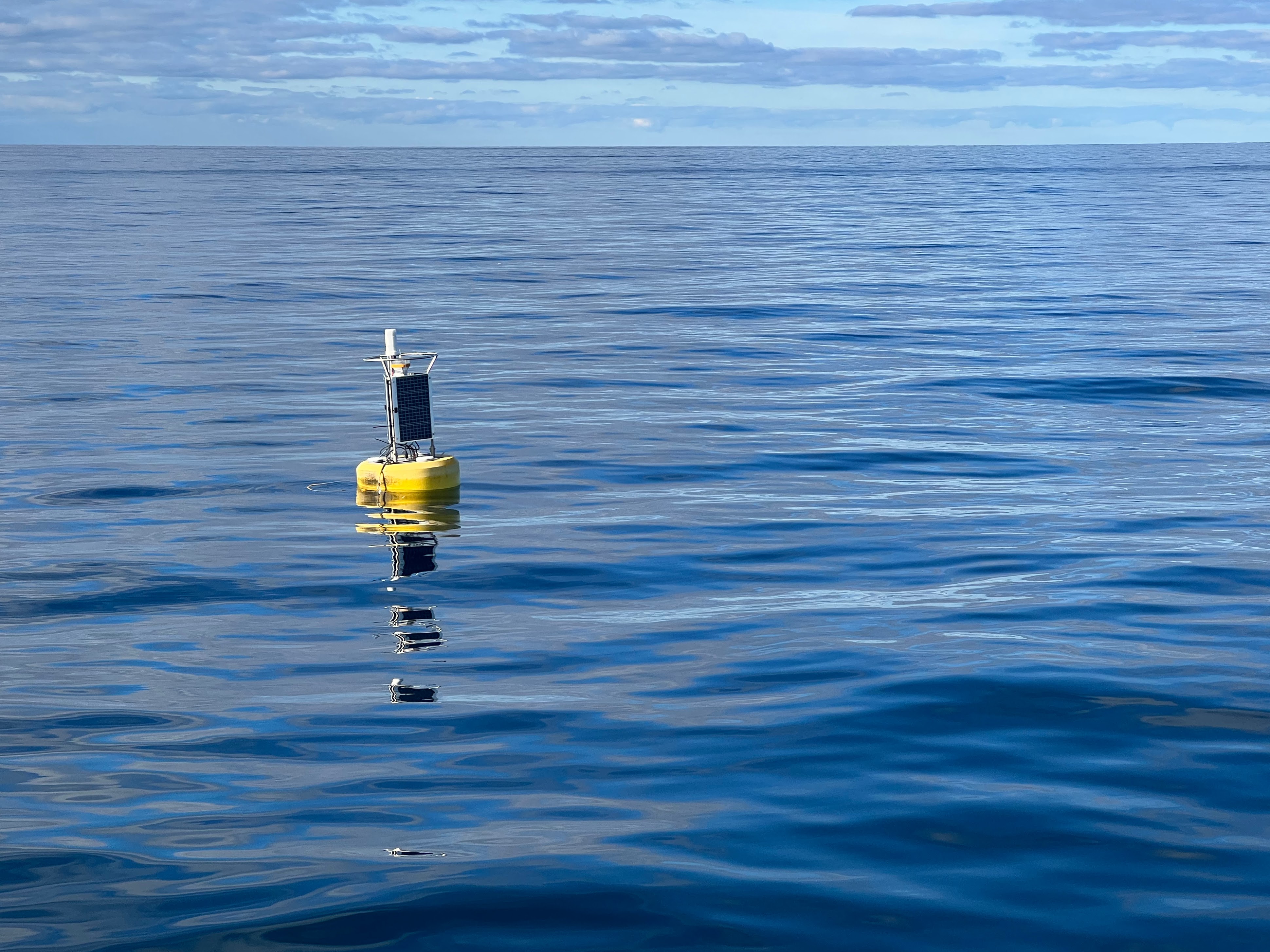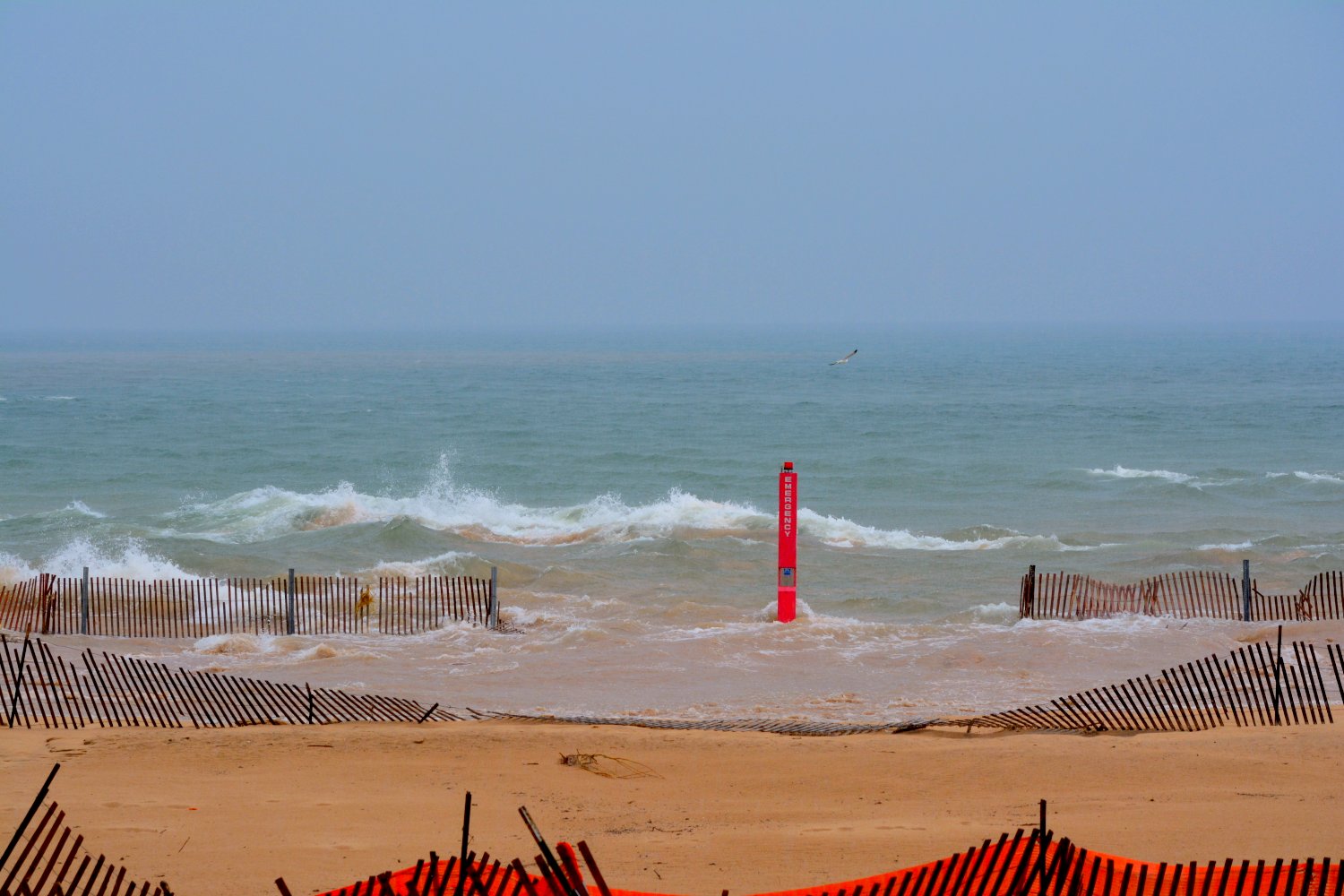
People love the expansive shorelines of the Great Lakes, and will often hit the beach on a warm summer afternoon to swim, play and cool off. But scientists have recently discovered that meteotsunamis – waves caused by sudden atmospheric pressure changes – can sometimes strike lake shores. These waves can hit even in seemingly fair weather, causing dangerous swimming conditions and occasionally damage property and shoreline infrastructure.
In order to better understand these waves and the conditions in which they may develop, scientists at NOAA’s Great Lakes Environmental Research Laboratory (GLERL) have begun monitoring lake waters with a new experimental buoy, originally designed to warn populations around the Pacific Ocean to the threat of seismic, or earthquake-induced tsunami waves. This experimental buoy, outfitted with sophisticated sensors, was first deployed in Lake Michigan during 2021.
The research work began in 2018, after one of these waves surged onto the beach of Lake Michigan near Ludington, Michigan, damaging homes and boat docks on an afternoon when large destructive waves should not have been present.

Scientists were later able to use citizen photos and other observational data to determine that the wave was actually a meteotsunami caused by a gravity wave moving across Lake Michigan. This type of wave in the atmosphere is associated with a rapid decrease and then rapid increase in surface pressure. They are part of our atmosphere, but most of the time they can pass through without causing any meaningful disturbances on the surface of the lake. On this particular day the conditions surrounding the gravity wave and the associated pressure changes interacted with the waters of Lake Michigan, resulting in a series of damaging waves.
The Ludington wave was the first time that experts were able to confirm that a gravity wave was occurring in the Great Lakes.
“This was the first time we were able to successfully reproduce a meteotsunami through modeling, opening the door for enhanced understanding without having to wait for the next dangerous situation to unfold,” says Bryan Mroczka, a GLERL physical scientist and meteorologist.
These large waves are most often formed from a thunderstorm moving across a lake. Thunderstorms in the right configuration can result in rapid rising and falling of air pressure that influences the water below, as it synchronizes with the water movement on the lake’s surface. Meteotsunamis are a “Goldilocks” type of event, everything has to be just right. If the thunderstorm complex and pressure wave are moving too slow or too fast for the particular lake, then a meteotsunami will not form.
“The beaches are one of the Great Lakes’ most loved natural resources,” says Mroczka. “Most people are used to thinking that once the sun comes out, the dangers of a storm have passed. However, these meteotsunami waves can be deadly and destructive, and continue to impact the lakes for hours after the rain and thunder have stopped.”
Not every thunderstorm or atmospheric gravity wave will produce a meteotsunami, but when the right conditions are present for their formation, the risk for beach goers and swimmers can even impact areas hundreds of miles away that did not experience the storm. Meteotsunamis can also increase the threat of dangerous rip currents for several hours after the initial waves.
The documentation of the 2018 wave spurred discussions between GLERL’s scientists and those doing tsunami deduction research at NOAA’s Pacific Marine Environmental Lab, and a new tsunami buoy was deployed in central Lake Michigan. This year, GLERL took over ownership of the instrument, which is now recording information that had not been officially observed in real time before.
The buoy is anchored to the floor of Lake Michigan, and monitors water levels to look for anomalies that suggest a meteotsunami is passing. The new data may eventually provide NOAA GLERL the ability to detect and possibly anticipate when one of these dangerous waves will hit the shores in near real-time. Advanced warning through these buoy observations and experimental modeling efforts could also improve rip current detection and provide better warning systems to improve beach safety.

GLERL scientists emphasize that the buoy is not intended to detect seismic events in the Great Lakes, although its design was somewhat based on other buoys in the Pacific that do detect things like earthquakes. In December of 2021, for example, the buoy recorded an atmospheric pressure wave’s influence on the lake water level as it circled the globe after the eruption of Hunga Tonga. Although this volcanic pressure wave was moving too fast to result in any unusual waves in the Great Lakes, it does show the variety of atmospheric phenomena that can potentially be triggers for meteotsunamis under the right circumstances.
While the 2018 Ludington wave was documented by modern photography, history reveals news stories of large waves from the past that were likely the result of meteotsunamis. On July 4, 1929 a large wave reportedly killed 10 people who were swept off a pier in Grand Haven, Michigan by a large wave following a morning thunderstorm. And in June 1954, a famous “freak wave” was described by eyewitnesses along the Chicago lakeshore before it killed 8 people. That particular wave was recorded just after the same weather pattern – a very strong thunderstorm was followed by beautiful clear weather. More recently, another July 4 storm hit Warren Dunes State Park in Michigan in 2003, causing a meteotsunami and killing seven swimmers caught in the resulting rip currents that formed after the wave had passed. All these waves were likely also meteotsunamis.
“It is exciting to get new information about our lake systems, and this buoy provides a whole new way to look at how the weather impacts the waters of the Great Lakes and our beaches,” says Mroczka. “Our goal is to understand the dynamics of these events better so that people can keep enjoying the lakes without worrying about meteotsunamis.”
